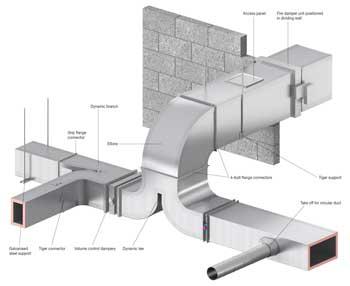|
There is no question that saving energy is high on everybody’s agenda right now. The gap between design performance and actual performance is rapidly closing, and legislation to ensure that buildings are constructed with at least a minimum level of insulation is becoming increasingly stringent. As the Building Code maintains its focus on performance as opposed to prescriptive design and construction, it actively encourages innovation and developments in new building technologies and energy saving systems such as the KoolDuct pre-insulated ductwork system from Kingspan. HVAC ductwork is traditionally constructed using galvanised mild sheet steel with mineral fibre insulation installed as a separate construction activity. A much more modern and innovative approach is to use pre-insulated ductwork, such as that fabricated using the Kingspan KoolDuct system, which comprises ductwork sections fabricated from premium performance rigid insulation panels with aluminium surfaces, installed in a single fix. The sealing methods and jointing systems used to connect the sections can lead to comparatively very air tight ductwork systems, providing the optimum energy saving and environmental solution in air-distribution ductwork.
As the table demonstrates, the results for ductwork fabricated using the Kingspan KoolDuct show a saving of 31% of the energy required to run a fan in an HVAC system with a typical design flow rate of 7.5 m/s, and there are potentially even greater savings at lower flow rates. Having established that there were significant energy savings to be made by using the Kingspan KoolDuct system, the next logical step was to look at the implications of reduced fan power on actual energy usage, the size of the fan needed and capital cost. Independent consultants Rider Levett Bucknall were commissioned to carry out this further review, which threw up some significant findings. The size of the fan required to deliver the designed air flow in a duct is directly related to the amount of air leakage in the system. For a typical design flow rate of 7.5 m/s, the air tightness of ductwork fabricated using the Kingspan KoolDuct System yielded an air leakage rate that was 11.6% lower than the galvanised sheet steel alternative. The resulting potential reduction in fan size can allow a saving of approximately 10% on the capital cost of the fan. |
With a k-value of 0.021 W/m.K, the premium performance Kingspan KoolDuct panels used in the fabrication process have the lowest k-value of any commonly used duct insulation product on the market today. For example, a 22mm panel is R-1.047 whilst a 30 mm panel is R-1.428. The panels also have a non-fibrous insulation core, minimising any risk of loose fibres entering the air handling system. This makes the System eminently suitable for high specification projects such as pharmaceuticals, data centres and hospitals. Meeting the requirements of the Building Code is one thing, but the inherent properties of the KoolDuct pre-insulated ductwork can also count towards achieving Green Star credit, helping those who wish to go one step further down the road of environmentally responsible construction to reach an optimum rating under this important national scheme. It can do this not only because of the very high levels of energy efficiency it provides, but also because of its zero ODP and low GWP. For further information about the Green Star system visit: www.nzgbc.org.nz/main/greenstar If you are going to the trouble of insulating ductwork in order to save energy, it surely makes sense to get the most out of those savings by using the most thermally efficient and airtight solutions available. Specifiers, contractors and building owners alike need to ask themselves whether they can really afford the luxury of ignoring the clear advantages that pre-insulated ductwork has to offer, and the triple benefits it brings of cutting energy, cutting carbon and cutting costs. This article has been written by Kingspan Insulation Limited. Kingspan Insulation distributes its KoolDuct System products throughout New Zealand via Forman Building Systems Ltd. For further information, please contact Forman Building Systems Ltd. The Kingspan KoolDuct System of Pre-insulated ductwork Fabrication Using the 4 Bolt Flange
|







